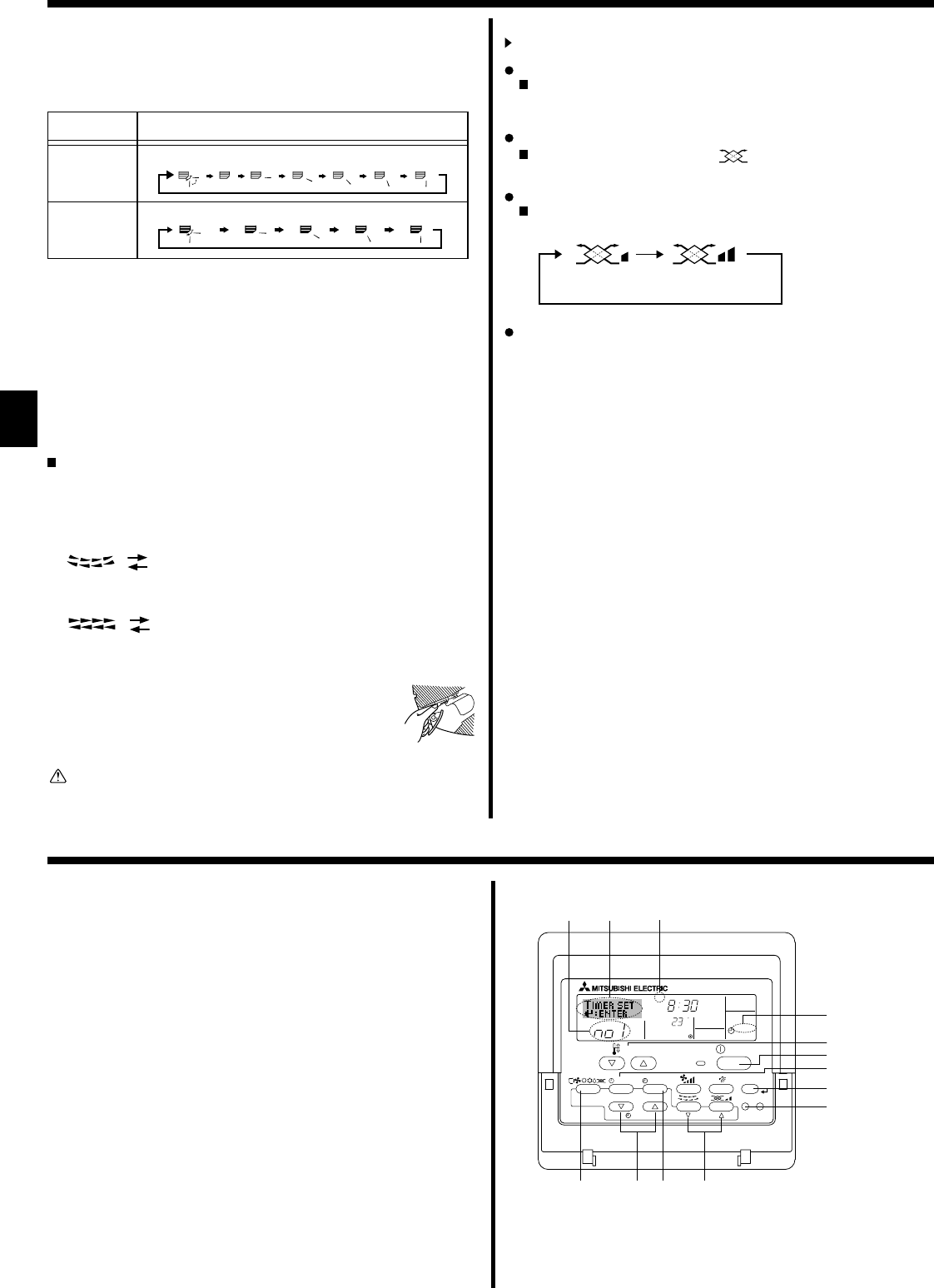
8
5. Operation
Note:
● Available directions depend on the type of unit connected.
● In the following cases, the actual air direction will differ from the direction
indicated on the remote controller display.
1. While the display is showing “STAND BY” or “DEFROST”.
2. Immediately after starting heat mode (while the system is waiting for the
mode change to take effect).
3.
In heat mode, when room temperature is higher than the temperature setting.
<To Change the Right/Left Air Direction> (Only for PS type)
Press the louver button
7
as necessary.
• The louver image
7
appears.
Each press of the button switches the setting as follows.
5.6. Ventillation
For LOSSNAY combination
5.6.1. For Wired Remote-controller
To run the ventilator together with the indoor unit:
Press the ON/OFF button
1
.
•
The Vent indication appears on the screen (at
8
). The ventilator
will now automatically operate whenever the indoor unit is running.
To run the ventilator only when the indoor unit is off:
Press the Mode button
2
until appears on the display. This
will cause the ventilator to start.
To change the ventilator force:
Press the Ventilation button
8
as necessary.
• Each press toggles the setting as shown below.
Note:
With some model confi gurations, the fan on the indoor unit may
come on even when you set the ventilator to run independently.
(ON)
(OFF)
During swing operation, the arrow display
move to the left and right.
No display
(Stop)
Wired remote
controller
Wireless remote
controller
No display
(Stop)
During swing operation, the arrow display
move to the left and right.
(Low)
(High)
6. Timer
6.1. For Wired Remote-controller
You can use Function Selection of remote controller to select which of
3 types of timer to use: 1 Weekly timer, 2 Simple timer, or 3 Auto Off
timer.
6.1.1. Weekly Timer
■
The weekly timer can be used to set up to 8 operations for each day
of the week.
• Each operation may consist of any of the following: ON/OFF time
together with a temperature setting, or ON/OFF time only, or tem-
perature setting only.
• When the current time reaches a time set at this timer, the air condi-
tioner carries out the action set by the timer.
■
Time setting resolution for this timer is 1 minute.
<How to Set the Weekly Timer>
1. Be sure that you are at a standard control screen, and that the weekly
timer indicator 1 is shown in the display.
Operation No.
Day Setting
C
SUN
ON
WEEKLY
PAR-21MAA
ON/OFF
FILTER
CHECK
OPERATION
CLEAR
TEST
TEMP.
MENU
BACK DAY
MONITOR/SET
CLOCK
ON/OFF
42 3
1
3
1
2
4
0
2
1
9
78
<[Manual] To Change the Airfl ow’s Left/Right Direction>
* The louver button
7
cannot be used.
• Stop the unit operation, hold the lever of the louver,
and
adjust to the desired direction.
* Do not set to the inside direction when the unit is
in the cooling or drying mode because there is a
risk of condensation and water dripping.
Caution:
To prevent falls, maintain a stable footing when operating the unit.
* Note that during swing operation, the directional indication on the
screen does not change in sync with the directional vanes on the unit.
5.5. Airfl ow direction setting
<To Change the Airfl ow’s Up/Down Direction> (PCA-KA, PKA-HAL)
■
With the unit running, press the Airfl ow Up/Down button 6 as necessary.
•
Each press changes the direction. The current direction is shown at 6.
• The change sequence and the available settings are as follows.
Remote controller Display
Wired type
Wireless type
Swing
Auto 1 2
3
4
5
Swing
2
3
41
Note:
*1. Weekly Timer/Simple Timer/Auto Off Timer cannot be used at the same
time.
*2. The weekly timer will not operate when any of the following conditions is
in effect.
The timer feature is off; the system is in an malfunction state; a test run
is in progress; the remote controller is undergoing self-check or remote
controller check; the user is in the process of setting a function; the user
is in the process of setting the timer; the user is in the process of setting
the current day of the week or time; the system is under central control.
(Specifi cally, the system will not carry out operations (unit on, unit off or
temperature setting) that are prohibited during these conditions.)


















